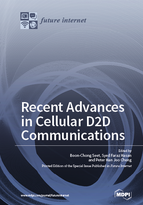Recent Advances in Cellular D2D Communications
A special issue of Future Internet (ISSN 1999-5903).
Deadline for manuscript submissions: closed (30 September 2017) | Viewed by 74710
Special Issue Editors
Interests: 5G wireless communications; antennas and radio frequency based sensors; smart textile and wearable technologies
Special Issues, Collections and Topics in MDPI journals
Interests: device-to-device communication; 5G networks; D2D discovery; mobile personal cells
Interests: machine learning techniques applied to software defined vehicular networks; wireless/mobile communications systems including radio resource management, multiple access, MANETs/VANETs, green radio networks, and 5G-V2X networks
Special Issues, Collections and Topics in MDPI journals
Special Issue Information
Dear Colleagues,
Device-to-device (D2D) communications have attracted a great deal of attention from researchers in recent years. It is a promising technique for offloading local traffic from cellular base stations by allowing local devices, in physical proximity, to communicate directly with each other. Furthermore, the resulting short-range communications can enable local devices to realize higher data rates, lower communication latency, and reduced power consumption. Through relaying, D2D is also a promising approach to enhancing service coverage, particularly at cell edges or in black spots within the cell. In addition to improving network performance and service quality, D2D can open up opportunities for new proximity-based services and applications for cellular users.
However, there are many challenges to realizing the full benefits of D2D. For one, minimizing the interference between legacy cellular and D2D users, operating in underlay mode, is still an active research issue. With 5G expected to be the main carrier for IoT traffic, the potential role of D2D and its scalability to support massive IoT devices and their machine-centric (as opposed to human-centric) communications need to be investigated. New challenges have also arisen from new enabling technologies for D2D communications, such as millimeter-wave and massive MIMO (multiple-input and multiple-output) systems, which call for new solutions to be proposed. The aforementioned matters are just a few examples of the many challenges that remain to be addressed.
This Special Issue aims to present a collection of exciting papers, reporting the most recent advances in cellular D2D communications. Topics of interests include, but are not limited to:
- Interference and power control for D2D communications
- Radio resource allocation and scheduling for D2D communications
- Machine-centric scalable D2D communications for 5G IoT
- D2D communications with relaying in millimeter-wave 5G networks
- Massive MIMO with D2D communications
- Fog/Cloud based 5G radio access networks with D2D communications
- Network coding in D2D communications
- D2D communications in vehicular environments
- Non-orthogonal multiple access (NOMA) based D2D group communications
- Energy harvesting based D2D communications
- Big data based optimization of cellular network with D2D communications
- Novel new services and applications
Dr. Boon-Chong Seet
Dr. Syed Faraz Hasan
Prof. Peter Chong
Guest Editors
Manuscript Submission Information
Manuscripts should be submitted online at www.mdpi.com by registering and logging in to this website. Once you are registered, click here to go to the submission form. Manuscripts can be submitted until the deadline. All submissions that pass pre-check are peer-reviewed. Accepted papers will be published continuously in the journal (as soon as accepted) and will be listed together on the special issue website. Research articles, review articles as well as short communications are invited. For planned papers, a title and short abstract (about 100 words) can be sent to the Editorial Office for announcement on this website.
Submitted manuscripts should not have been published previously, nor be under consideration for publication elsewhere (except conference proceedings papers). All manuscripts are thoroughly refereed through a single-blind peer-review process. A guide for authors and other relevant information for submission of manuscripts is available on the Instructions for Authors page. Future Internet is an international peer-reviewed open access monthly journal published by MDPI.
Please visit the Instructions for Authors page before submitting a manuscript. The Article Processing Charge (APC) for publication in this open access journal is 1600 CHF (Swiss Francs). Submitted papers should be well formatted and use good English. Authors may use MDPI's English editing service prior to publication or during author revisions.
Keywords
- cellular
- interference
- resource allocation
- machine-centric
- internet-of-things
- millimeter-wave
- massive mimo
- non-orthogonal multiple access
- energy harvesting








